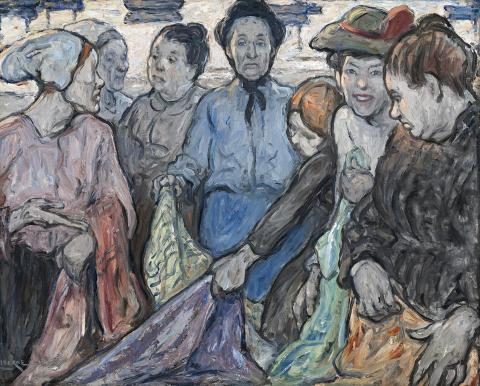LES ACHETEUSES (THE BUYERS), c.1913
ISO RAE
oil on canvas
80.0 x 99.5 cm
signed lower left: ISO RAE
bears inscription verso: 163
Private collection, Sweden
Bonhams and Goodman, Sydney, 26 April 2005, lot 39
Private collection, Melbourne
Company collection, Sydney
Salon de la Société Nationale des Beaux-Arts (New Salon), Paris, April 1913, cat. 1030
‘The Paris Salon’, Daily Telegraph, Sydney, 31 May 1913
Lesage, J. – C., Peintres Australiens à Étaples, AMME Editions, Etaples-sur-Mer, France, 2000, p. 18
The work of Iso (Isobel) Rae is relatively little-known and rarely seen in Australia. Although she was born in Melbourne and studied at the National Gallery School between 1878 – 1887, Rae lived most of her adult life overseas and much of her work has remained in Europe. Travelling with her sister, Alison, and their mother, Rae left Australia in August 1887 heading for Paris which, in Rupert Bunny’s words, was ‘the one place in the world to study for the man who wants to do really good work. Nowhere else does he get the atmosphere, the sympathy, which is indispensable to the serious student of painting’.1 Paris also offered opportunities for female art students and Rae continued her education at Académie Colarossi, probably also studying at the private school run by the American painter, Henry Mosler.2 She exhibited widely – at the Old Salon and the Société Nationale des Beaux-Arts (New Salon) in Paris, and in London with the Royal Society of British Artists and the Society of Oil Painters – achieving considerable success. Notably, her painting Pierrot, 1892 was acquired that same year for the Musée Quentovic in Étaples, making it possibly the first work by an Australian artist to be purchased by a French museum.3
It was in the summer of 1889 that Rae first visited Étaples, a fishing village in Brittany on the northern coast of France and site of a popular artists’ colony. While the picturesque rural landscape and creative community of Étaples attracted visitors from all over the world, there was a particularly strong concentration of Australian artists who lived and worked there from the 1880s to the early twentieth century, including James Quinn, Edward Officer and Hilda Rix Nicholas, as well as many others such as Bunny and E. Philips Fox who visited for shorter periods. Iso and Alison Rae were among the longest-serving expatriate residents, living there permanently from 1892 – 1932. During the First World War, Étaples was a training and staging base for allied soldiers and while Alison worked in a military hospital, Iso made her contribution at the nearby YMCA camp. In her spare time, she documented aspects of camp life in an important series of pastel drawings that is now her best-known work (represented in various public collections including the Australian War Memorial and the National Gallery of Australia).4
Living in Étaples for forty years, Rae became entrenched in local life and, as French art-historian Jean-Claude Lesage has noted, she ‘observed the local population and the rites of a community: the market, the processions, funerals and other blessings’.5 In this work, Rae depicts a group of women sorting through pieces of fabric at a market, small boats moored in the harbour behind them just visible in the background. Defining her subjects with a dark painted line and using a limited palette of colours, Rae takes obvious pleasure in the depiction of her female subjects who are of various ages and drawn from a range of social classes. Carefully describing their dress, head-wear and facial expressions, she contrasts the delight of a smiling young woman on the right with the more mature centrally placed figure, whose expression is one of weary resignation. Exhibited in the Société Nationale des Beaux-Arts in 1913, Les acheteuses (The buyers), c.1913 caught the attention of the Sydney Daily Telegraph art critic who described the painting as ‘a clever sketch of some Breton (sic) fishwives … (that) has more the quality of a charcoal sketch but the drawing is good and the figures full of movement and character’. 6
1. Bunny, R. quoted in Taylor, E., Australian Impressionists in France, exhibition catalogue, National Gallery of Victoria, Melbourne, 2013, p. 11
2. ibid., p. 19
3. ibid.
4. See Speck, C., Painting Ghosts: Australian Women Artists in Wartime, Craftsman House, Fishermans Bend, 2004, pp. 37 – 45
5. Lesage, J., Peintures Australiens à Étaples (English translation), A. M. M. E. Editions, Étaples, 2000, p. 18
6. ‘The Paris Salon’, Daily Telegraph, Sydney, 31 May 1913
KIRSTY GRANT
